Fuzzy Sliding Mode Wheel Slip Ratio Control for Smart Vehicle Anti-Lock Braking System
Abstract
1. Introduction
- These papers just consider a few well-known forces during vehicle dynamics analyses. Usually, one or two of the drag forces from air and the wheel rolling friction force are ignored, which leads to unrealistic model building.
- During the simulation, the initial control point is given as zero (for, e.g., wheel slip ratio and braking torque) and the simulation does not consider disturbances that exist during vehicle braking, which makes the control situation too simple and does not meet the actual situation.
- In these CAB designs, road conditions during braking simulations are all given as the known parameters, which do not match the actual braking situation.
- As we all know, when the wheel is in the anti-lock state, there must exist the wheel rolling friction force. Besides, when the vehicle is running, it must withstand air resistance. Under normal circumstances, this air drag force is positively related to the vehicle’s velocity. Therefore, the vehicle model establishment here contains both the drag force from air and the wheel rolling friction force.
- In the case of real vehicle braking, it should be that when the wheel slip rate is too high and there is a risk of locking, the ABS starts to control the wheel to maintain the anti-lock state. Therefore, it is impossible to start vehicle braking from the point where the wheel slip ratio is zero. To make the whole vehicle braking period more reasonable and further service the verification of this CAB’s control performance, select the wheel slip ratio as the initial braking point of all simulations.
- As a rule of thumb, when the ABS starts to operate, the initial control point is also affected by the vehicle model parameters themselves, that is, the speed displayed on the vehicle’s meter is not the initial speed of the brake. For this reason, during this simulation model, the vehicle initial drive state reflected by vehicle parameters are also considered.
- More realistic forces which can affect the braking effect to varying degrees are added.
- The whole control is made to start with difficult initial braking situations, which restores the actual car brakes as much as possible; for instance, the initial braking wheel slip ratio is set as 0.8 at dry roads; the initial vehicle braking state is related to this time’s vehicle velocity.
- The road condition automatic detection module is added, which can give the road condition and improve the control accuracy and intelligence.
2. Vehicle Dynamics
3. Design of Sliding Mode Wheel Slip Ratio Controller
3.1. Four Wheels Joint Control for Straight Line Case
3.2. The Wheel Braking Torque Module
3.3. The Fuzzy Part of the SMWSC
- , and are initial PID variables of the fuzzy PID controller.
- , and are correction PID variables of the fuzzy PID controller.
- , and are final output variables of the fuzzy PID controller.
3.4. The Sliding Mode Part of the SMWSC
4. Simulation
4.1. Establishment of the Vehicle model and the Control Module
4.2. Simulation Results and Discussions
- The improved PID-based CAB has a little shorter D on dry road compared with a normal PID-based CAB. However, the D of the improved PID-based CAB is slightly longer than the normal PID-based CAB on snow roads and ice roads with all the initial vehicle velocities.
- The stop distance of the two robustness type CABs are much shorter than the pure PID-based CABs on dry, wet, snow and ice roads with all the initial vehicle velocities.
- The fuzzy PID-based CABs have longer stop distance compared with fuzzy sliding mode based-CABs on all four road conditions with all the initial vehicle velocities, especially on dry roads.
- The braking torque of a normal PID-based CAB is the largest one on all the four road conditions with all the initial vehicle velocities compared with the other three types of CABs. Besides, of this normal PID-based CAB on dry and wet roads is very similar and is also very similar on snow roads and ice roads.
- The braking torque of the improved PID-based CAB is different on different road conditions with different initial vehicle velocities. Moreover, the improved PID-based CAB needs larger braking torque compared to the two robustness CABs, on almost all four kinds roads with different initial vehicle velocities.
- The two robustness CABs, fuzzy PID-based CAB and fuzzy sliding mode-based CAB, need smaller braking torque compared with pure PID-based CABs on all road conditions with all initial vehicle velocities.
- The wheel slip ratio of normal PID-based CABs is almost 1 on all road conditions with all initial vehicle velocities.
- The wheel slip ratio of improved PID-based CABs is close to 1 on dry and wet roads with all initial vehicle velocities. Besides, the wheel slip ratio of improved PID-based CABs is almost equal to 1 on snow roads with 70 km/h, 80 km/h, 90 km/h and 100 km/h and on ice roads with 90 km/h and 100 km/h.
- The wheel slip ratios of the two robustness CABs are small enough on all the four road conditions with all initial vehicle velocities compared with the other two pure PID-based CABs. In addition, the wheel slip ratios of these two robustness CABs are around on dry and wet roads and around on snow roads and ice roads; these slip ratios are all closer to the optimal slip ratio of different roads.
- On dry roads, the keeps within m even if the curve shifts left and right; the largest one is m at 100 km/h. Correspondingly, the braking torque required by the ABS controller under these road conditions is similar and its difference remains within 5 N· m.
- On wet roads, the keeps within m and the largest one is m at 100 km/h. To yield the small , the ABS controller will greatly adjust the braking torque, for example, N· m under road conditions.
- On snow roads, the keeps within m; most difference remains below 1 m. Correspondingly, the braking torque required by the ABS controller under these road conditions is similar and its difference remains within 1.9 N· m.
- On ice roads, the keeps within m; this data is below m under and . The braking torque required by the ABS controller under these road conditions is similar and its difference remains within 1 N· m.
- On dry roads, the with 100 km/h is m, others remain below 8 m. In addition, the braking torque adjustment is relatively strong; the largest one is 132.868 N· m on road with 100 km/h.
- On wet roads, increases and also increases. The largest one is m, 149.386 N· m) on road with 100 km/h.
- On snow roads, and all have large values; the largest one is m, 17.9476 N· m) on road with 100 km/h.
- On ice roads, and still have large values, the largest is m on road with 100 km/h, the largest is 17.146 N· m on road with 80 km/h.
- On dry roads, and are all very small; the largest is m with 1.3M and 80 km/h; the largest is 118.545 N· m with 1.3M and 100 km/h
- On wet roads, are all below m; the largest is m with 1.3M and 100 km/h; the largest is 82.724 N· m with 1.3M and 60 km/h
- On snow roads, are all below m; the largest is m with 1.3M and 100 km/h; the largest is 118.545 N· m with 1.3M and 60 km/h
- On ice roads, are all below m; the largest is m with 1.3M and 100 km/h; the largest is 118.545 N· m with 1.3M and 60 km/h.
5. Conclusions
- The assumptions: This proposed ABS controller is designed based on a straight-line case. Besides, real existing forces and real initial braking situations are all considered in the initial state of wheel slip ratio and vehicle braking torque state.
- The limitations: This sliding mode wheel slip controller is firstly established based on vehicle parameters, such as curve and vehicle mass, but then there are simulations to verify the effect of these parameters on the control effect. Through simulation results comparison, this control algorithm is verified to have enough robustness capability to resist these parameters’ disturbances.
- The relative merits: This proposed ABS controller has the road condition automatic detection module, which is new to the existing ABS controllers and can largely improve the intelligence performance.
Author Contributions
Funding
Conflicts of Interest
Appendix A
| Sign | Parameter | Value |
|---|---|---|
| D (m) | stop distance of vehicle | - |
| longitudinal wheel slip ratio | - | |
| (m/s) | vehicle longitudinal velocity | - |
| (rad/s) | wheel angular speed | - |
| friction coefficient of road | - | |
| wheel rolling friction coefficient | ||
| friction coefficient of braking disc | (two discs) | |
| M (kg) | full mass of vehicle | 938 (with two persons) |
| (m) | wheel radius | |
| (m) | radius of braking disc | |
| (kg) | mass of wheel | 12 |
| wheel inertia | ||
| (N) | drag force from air | - |
| air density | ||
| air resistance coefficient | ||
| air resistance area | ||
| (N) | friction force of single wheel | |
| (N) | rolling friction force of single wheel | |
| (N) | friction force from two pads | |
| (N) | required actuator force | |
| (N · m) | braking torque of single wheel |
References
- Satzger, C.; Castro, R.D. Predictive brake control for electric vehicles. IEEE Trans. Veh. Technol. 2018, 67, 977–990. [Google Scholar] [CrossRef]
- Castillo, J.J.; Cabrera, J.A.; Guerra, A.J.; Simón, A. A Novel Electrohydraulic Brake System With Tire–Road Friction Estimation and Continuous Brake Pressure Control. IEEE Trans. Ind. Electron. 2016, 63, 1863–1875. [Google Scholar] [CrossRef]
- Yuan, Y.; Zhang, J.Z.; Li, Y.T.; Li, C. A Novel Regenerative Electrohydraulic Brake System: Development and Hardware-in-Loop Tests. IEEE Trans. Veh. Technol. 2018, 67, 11440–11452. [Google Scholar] [CrossRef]
- Zhai, L.; Sun, T.M.; Wang, J. Electronic Stability Control Based on Motor Driving and Braking Torque Distribution for a Four In-Wheel Motor Drive Electric Vehicle. IEEE Trans. Veh. Technol. 2016, 65, 4726–4739. [Google Scholar] [CrossRef]
- Zhou, Y.; Cheng, K.W.E.; Ho, J.F.; Huang, S.D.; Pan, J.F. A New Decoupled RotLin Motor With Fuzzy Sliding Mode Control. IEEE Trans. Magnet. 2018, 54, 1–5. [Google Scholar]
- Wang, Y.F.; Fujimoto, H.; Hara, S.J. Driving Force Distribution and Control for EV With Four In-Wheel Motors: A Case Study of Acceleration on Split-Friction Surfaces. IEEE Trans. Ind. Electron. 2017, 64, 380–388. [Google Scholar] [CrossRef]
- Xue, X.D.; Cheng, K.W.E.; Ng, T.W.; Cheng, N.C. Multi-Objective Optimization Design of In-Wheel Switched Reluctance Motors in Electric Vehicles. IEEE Trans. Ind. Electron. 2010, 57, 2980–2987. [Google Scholar] [CrossRef]
- Zhang, L.; Yu, L.Y.; Wang, Z.Z.; Zuo, L.; Song, J. All-Wheel Braking Force Allocation During a Braking-in-Turn Maneuver for Vehicles With the Brake-by-Wire System Considering Braking Efficiency and Stability. IEEE Trans. Veh. Technol. 2016, 65, 4752–4767. [Google Scholar] [CrossRef]
- Zhang, C.Z.; Hu, J.F.; Qiu, J.B.; Yang, W.L.; Sun, H.; Chen, Q.J. A Novel Fuzzy Observer-Based Steering Control Approach for Path Tracking in Autonomous Vehicles. IEEE Trans. Ind. Electron. 2019, 27, 278–290. [Google Scholar] [CrossRef]
- Pacejka, H.B. Tire and Vehicle Dynamics, 3rd ed.; Elsiever/Butterworth-Heinemann: Amsterdam, The Netherlands, 2012. [Google Scholar]
- Wang, N.; Er, M.J.; Sun, J.C.; Liu, Y.C. Adaptive Robust Online Constructive Fuzzy Control of a Complex Surface Vehicle System. IEEE Trans. Cybern. 2016, 46, 1511–1523. [Google Scholar] [CrossRef]
- Zhang, Z.S.; Ma, R.H.; Wang, L.F.; Zhang, J.Z. Novel PMSM Control for Anti-Lock Braking Considering Transmission Properties of the Electric Vehicle. IEEE Trans. Veh. Technol. 2018, 67, 10378–10386. [Google Scholar] [CrossRef]
- Dadashnialehi, A.; Hadiashar, A.B.; Cao, Z.W.; Kapoor, A. Intelligent Sensorless ABS for In-Wheel Electric Vehicles. IEEE Trans. Ind. Electron. 2014, 61, 1957–1969. [Google Scholar] [CrossRef]
- Ivanov, V.; Savitski, D.; Shyrokau, B. A Survey of Traction Control and Antilock Braking Systems of Full Electric Vehicles With Individually Controlled Electric Motors. IEEE Trans. Veh. Technol. 2015, 64, 3878–3896. [Google Scholar] [CrossRef]
- Wei, Z.; Guo, X.X. An ABS Control Strategy for Commercial Vehicle. IEEE/ASME Trans. Mechatron. 2015, 20, 384–392. [Google Scholar] [CrossRef]
- Feng, J.W.; Bao, C.J.; Wu, J.; Cheng, S.; Xu, G.F.; Liu, S.F. Research on Methods of Active Steering Control Based on Receding Horizon Control. Energies 2018, 11, 2243. [Google Scholar] [CrossRef]
- Chen, Y.F.; Chen, I.M.; Chang, J.S.; Liu, T. Design and Analysis of a New Torque Vectoring System with a Ravigneaux Gearset for Vehicle Applications. Energies 2017, 10, 2157. [Google Scholar] [CrossRef]
- Romijn, C.; Donkers, T.; Kessels, J.; Weiland, S. Real-Time Distributed Economic Model Predictive Control for Complete Vehicle Energy Management. Energies 2017, 10, 1096. [Google Scholar] [CrossRef]
- Peng, J.K.; He, H.W.; Feng, N.L. Simulation Research on an Electric Vehicle Chassis System Based on a Collaborative Control System. Energies 2013, 6, 312–328. [Google Scholar] [CrossRef]
- Cao, W.H.; Liu, H.L.; Lin, C.; Chang, Y.H.; Liu, Z.Y.; Antoni, S. Co-Design Based Lateral Motion Control of All-Wheel-Independent-Drive Electric Vehicles with Network Congestion. Energies 2017, 10, 1641. [Google Scholar] [CrossRef]
- Xue, X.D.; Cheng, K.W.E.; Ho, S.L. Optimization and Evaluation of Torque-Sharing Functions for Torque Ripple Minimization in Switched Reluctance Motor Drives. IEEE Trans. Veh. Technol. 2009, 24, 2076–2090. [Google Scholar] [CrossRef]
- Sun, H.Z.; Wang, H.; Zhao, X.C. Line Braking Torque Allocation Scheme for Minimal Braking Loss of Four-Wheel-Drive Electric Vehicles. IEEE Trans. Veh. Technol. 2019, 68, 180–192. [Google Scholar] [CrossRef]
- Takagi, T.; Sugeno, M. Fuzzy identification of systems and its applications to modeling and control. IEEE Trans. Syst. 1985, 15, 116–132. [Google Scholar] [CrossRef]
- Peng, X.Y.; Jia, M.F.; He, L.; Yu, X.; Lv, Y.B. Fuzzy sliding mode control based on longitudinal force estimation for electro-mechanical braking systems using BLDC motor. CES Trans. Electr. Mach. Syst. 2018, 2, 142–151. [Google Scholar]
- Mirzaei, M.; Mirzaeinejad, H. Fuzzy Scheduled Optimal Control of Integrated Vehicle Braking and Steering Systems. IEEE/ASME Trans. Mechatron. 2017, 22, 2369–2379. [Google Scholar] [CrossRef]
- Guillaume, S. Designing fuzzy inference systems from data: An interpretability-oriented review. IEEE Trans. Fuzzy Syst. 2001, 9, 426–443. [Google Scholar] [CrossRef]
- Savitski, D.; Schleinin, D.; Ivanov, V.; Augsburg, K. Robust Continuous Wheel Slip Control With Reference Adaptation: Application to the Brake System With Decoupled Architecture. IEEE Trans. Ind. Inform. 2018, 14, 4212–4223. [Google Scholar] [CrossRef]
- Xue, X.D.; Cheng, K.W.E.; Ho, S.L. A Self-Training Numerical Method to Calculate the Magnetic Characteristics for Switched Reluctance Motor Drives. IEEE Trans. Magn. 2004, 40, 734–737. [Google Scholar] [CrossRef]
- Vakis, A.I.; Yastrebov, V.A.; Scheibert, J.; Nicola, L.; Dini, D.; Minfray, C.; Molinari, J.F. Modeling and simulation in tribology across scales: An overview. Tribol. Int. 2018, 125, 169–199. [Google Scholar] [CrossRef]
- Papangelo, A.; Ciavarella, M.; Hoffmann, N. Subcritical bifurcation in a self-excited single-degreeof-freedom system with velocity weakening strengthening friction law: Analytical results and comparison with experiments. Nonlinear Dyn. 2017, 90, 2037–2046. [Google Scholar] [CrossRef]
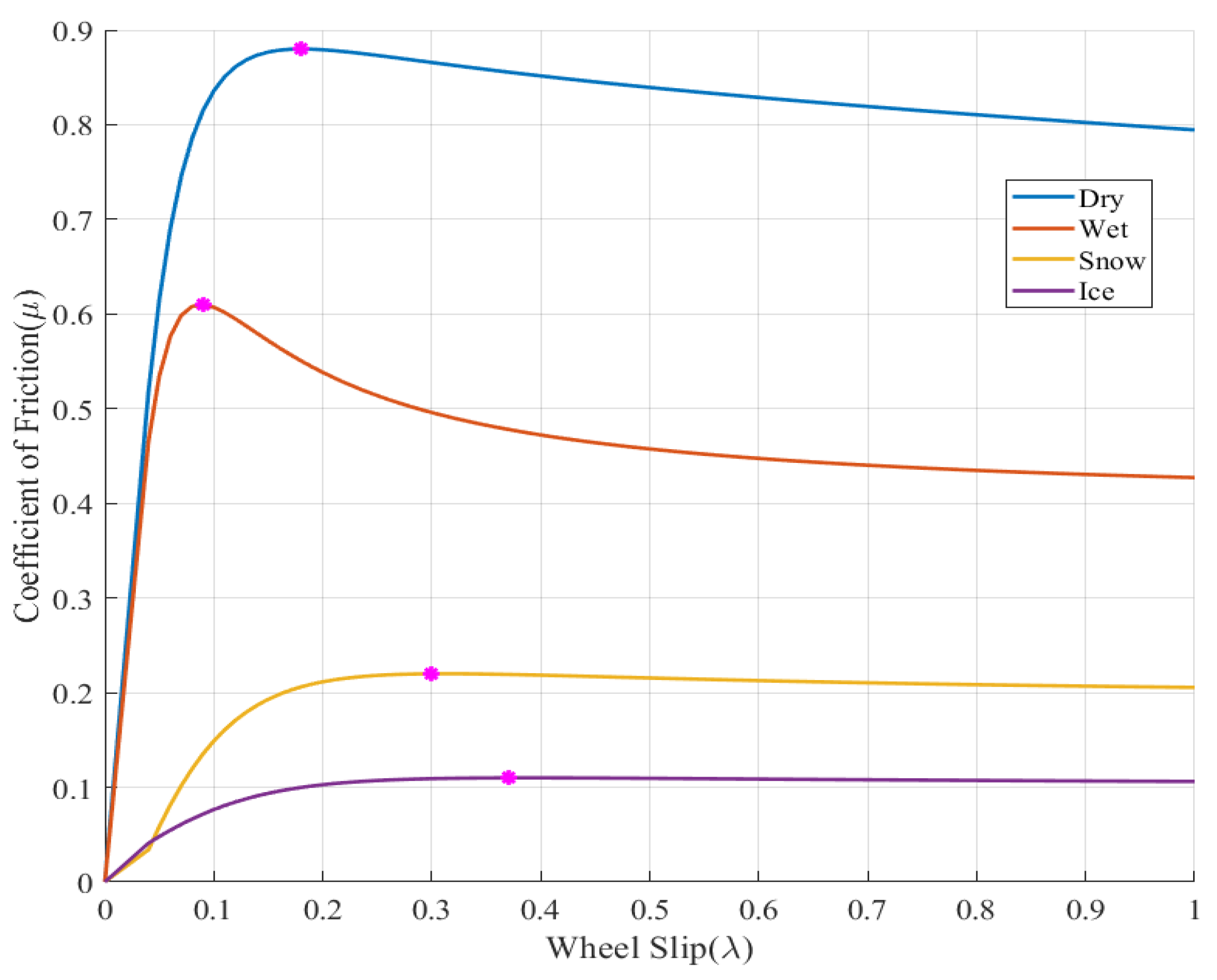
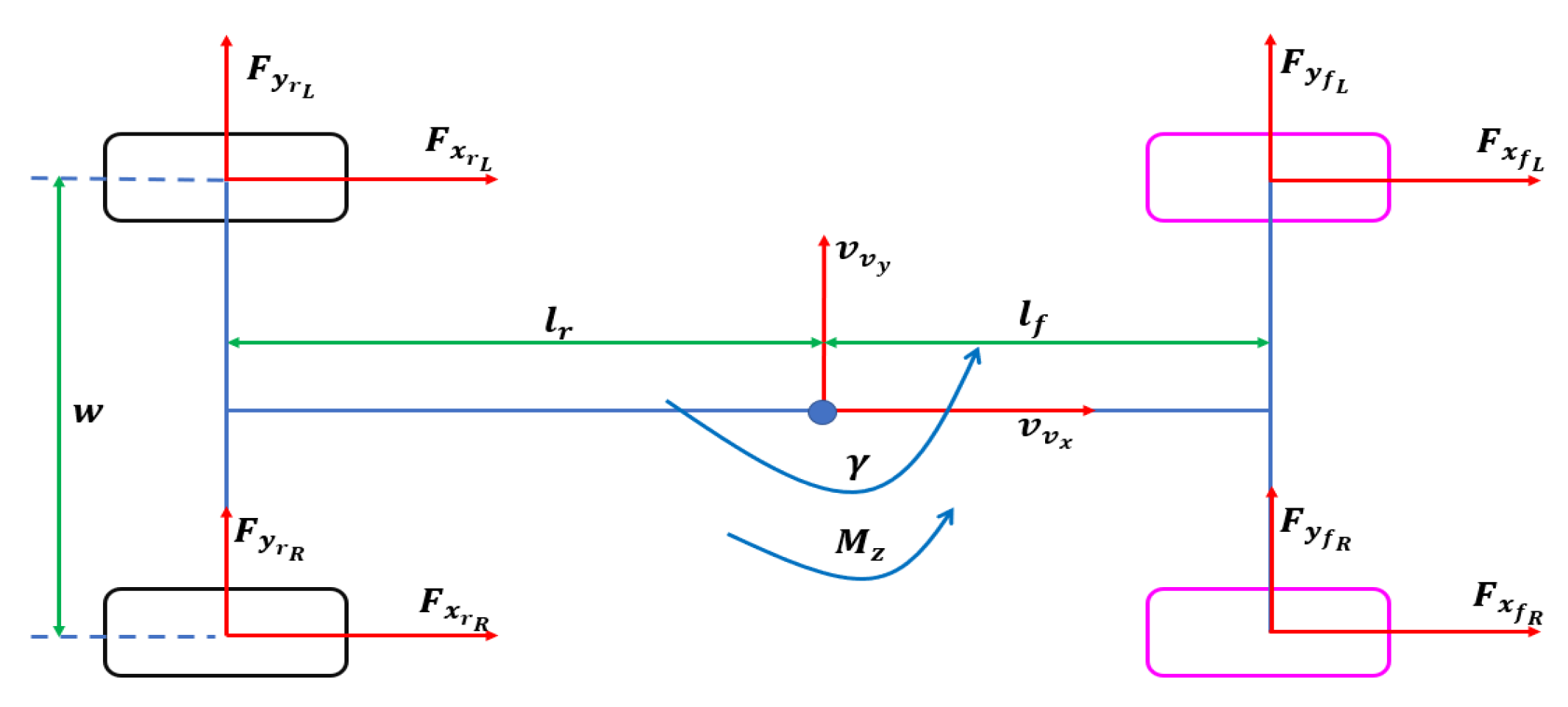
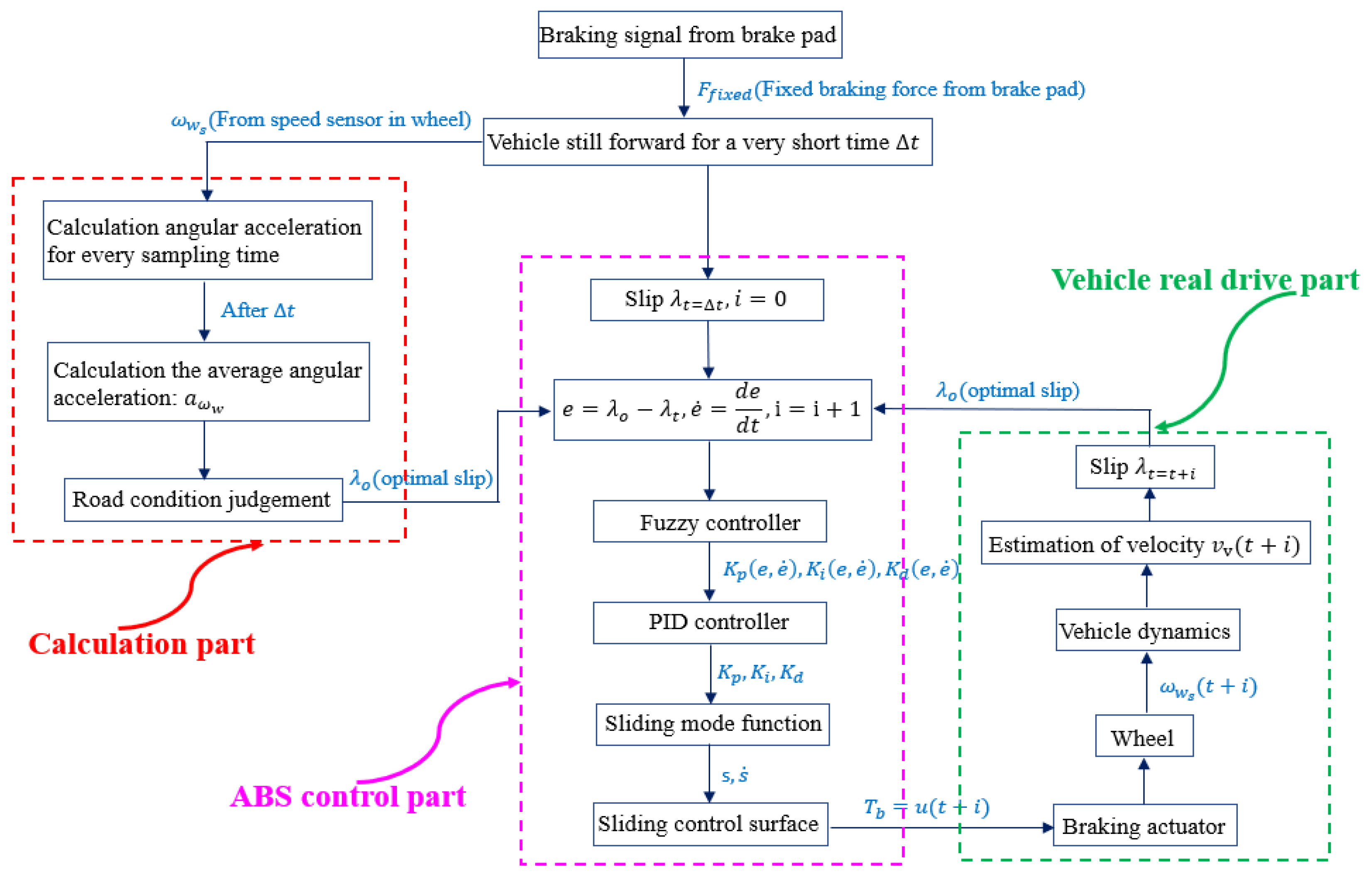
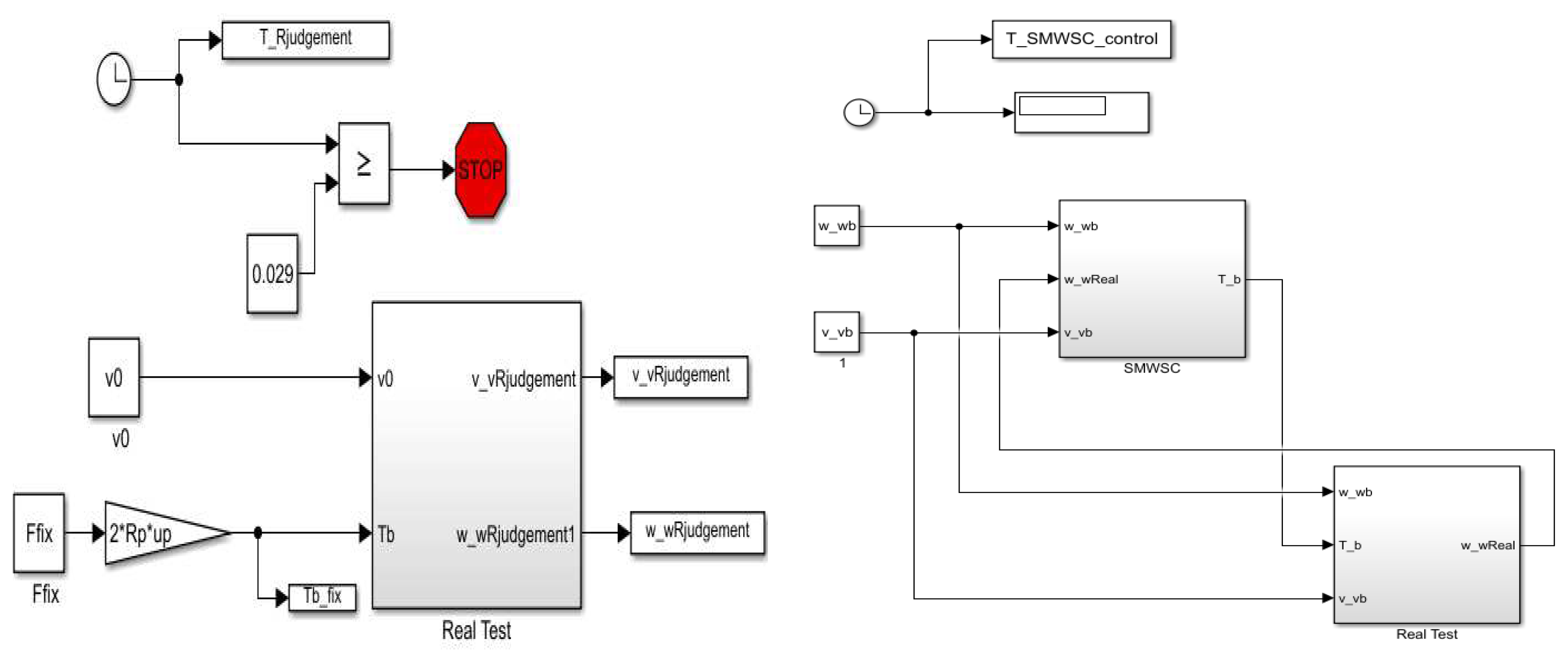
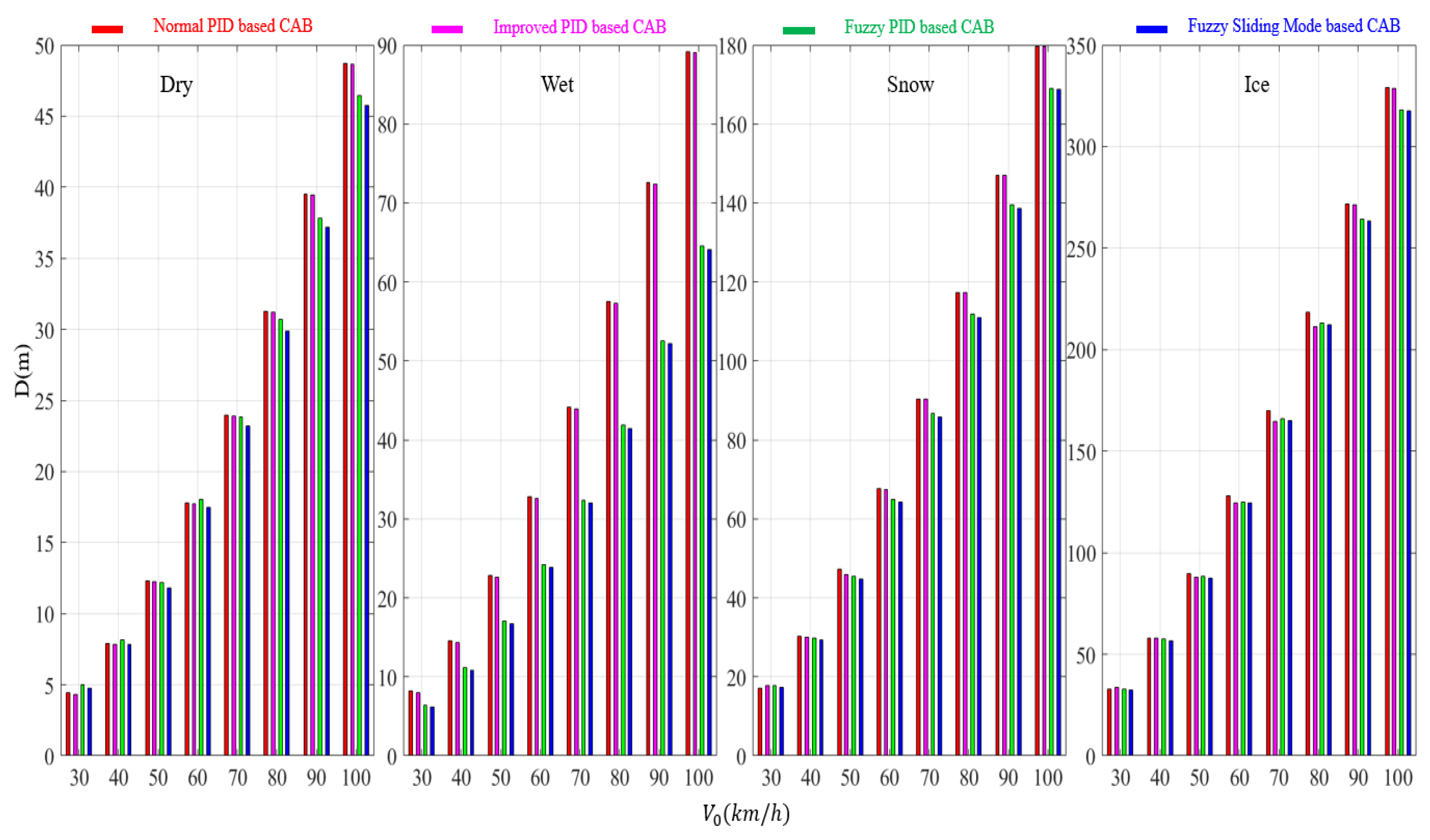

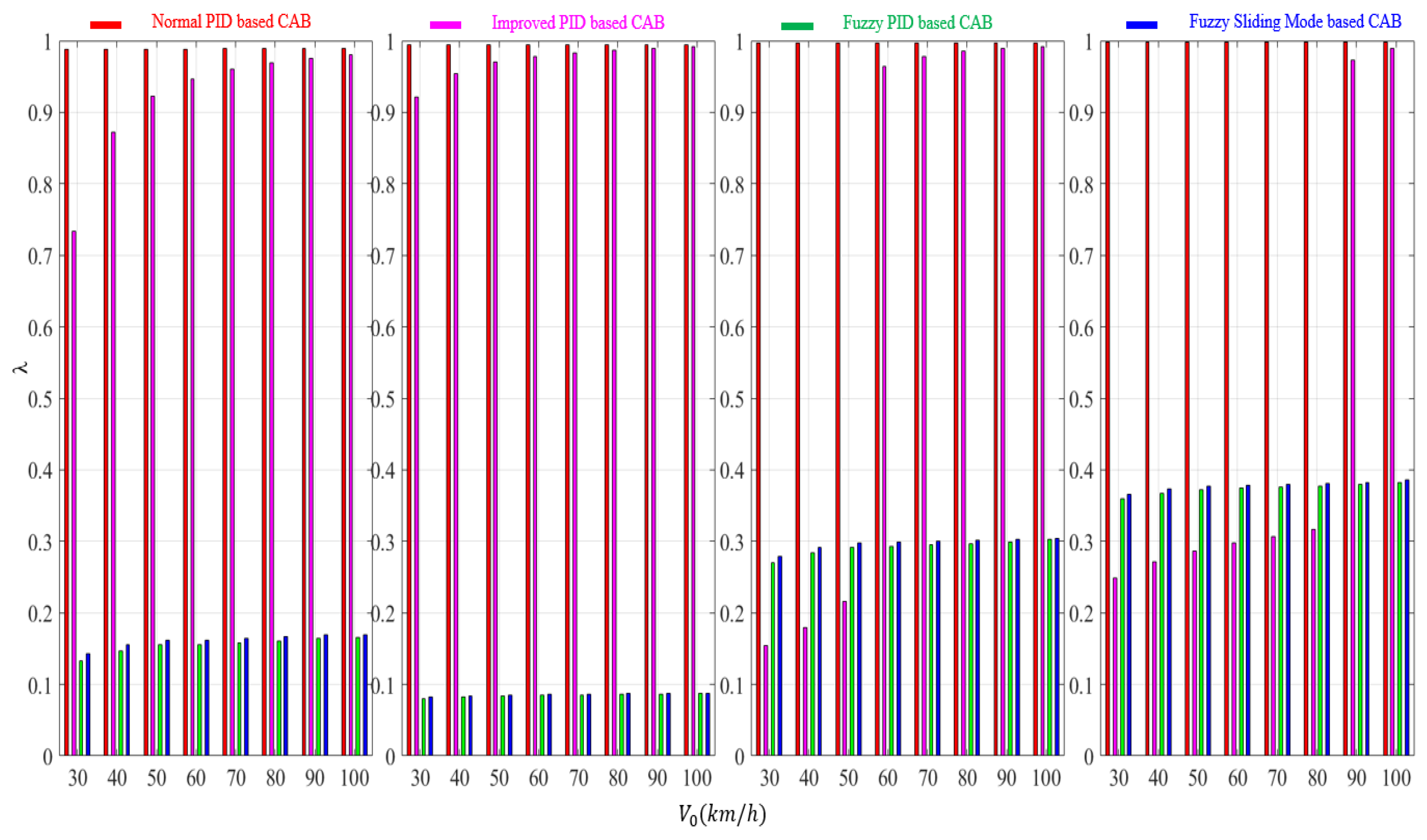

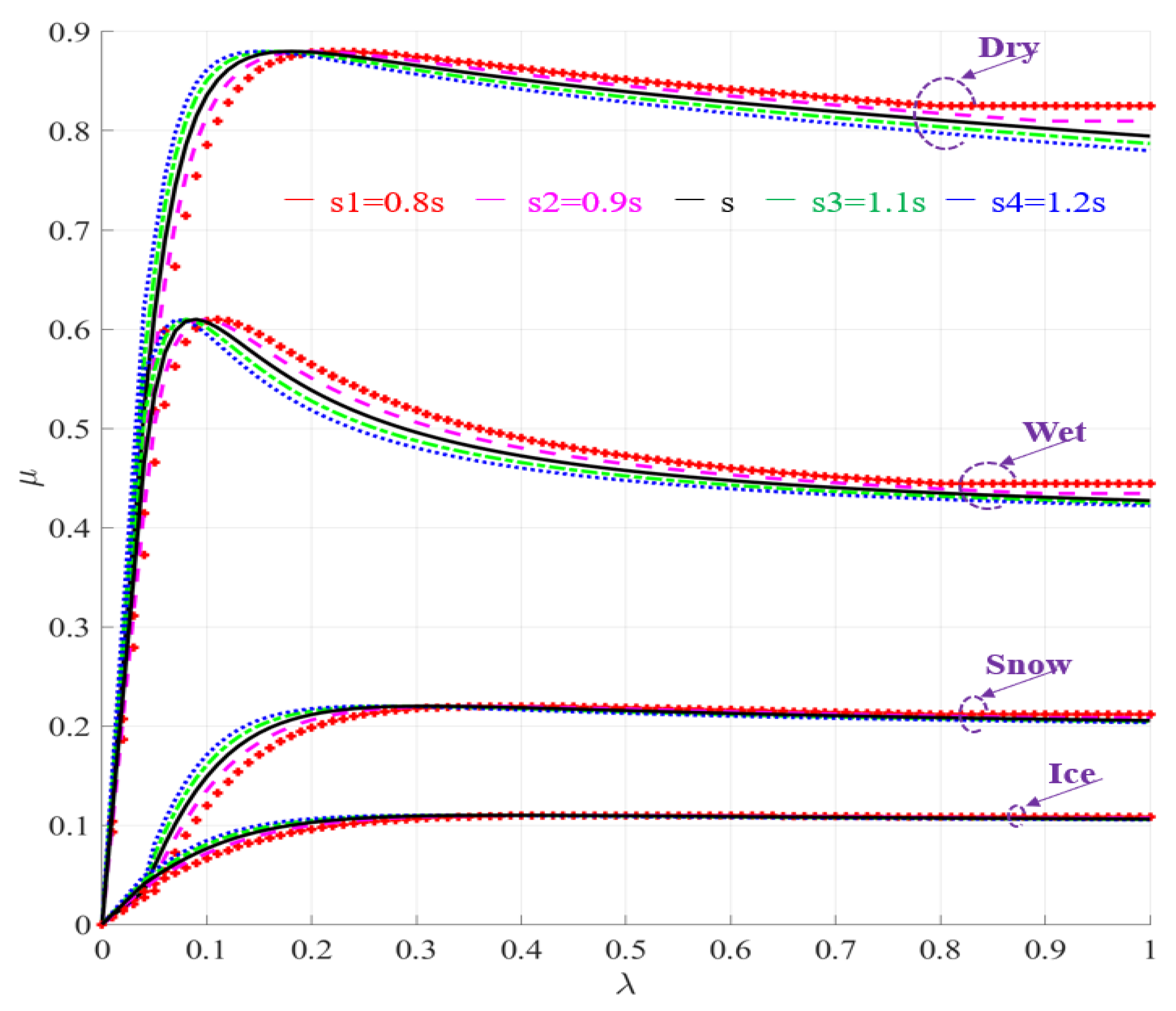
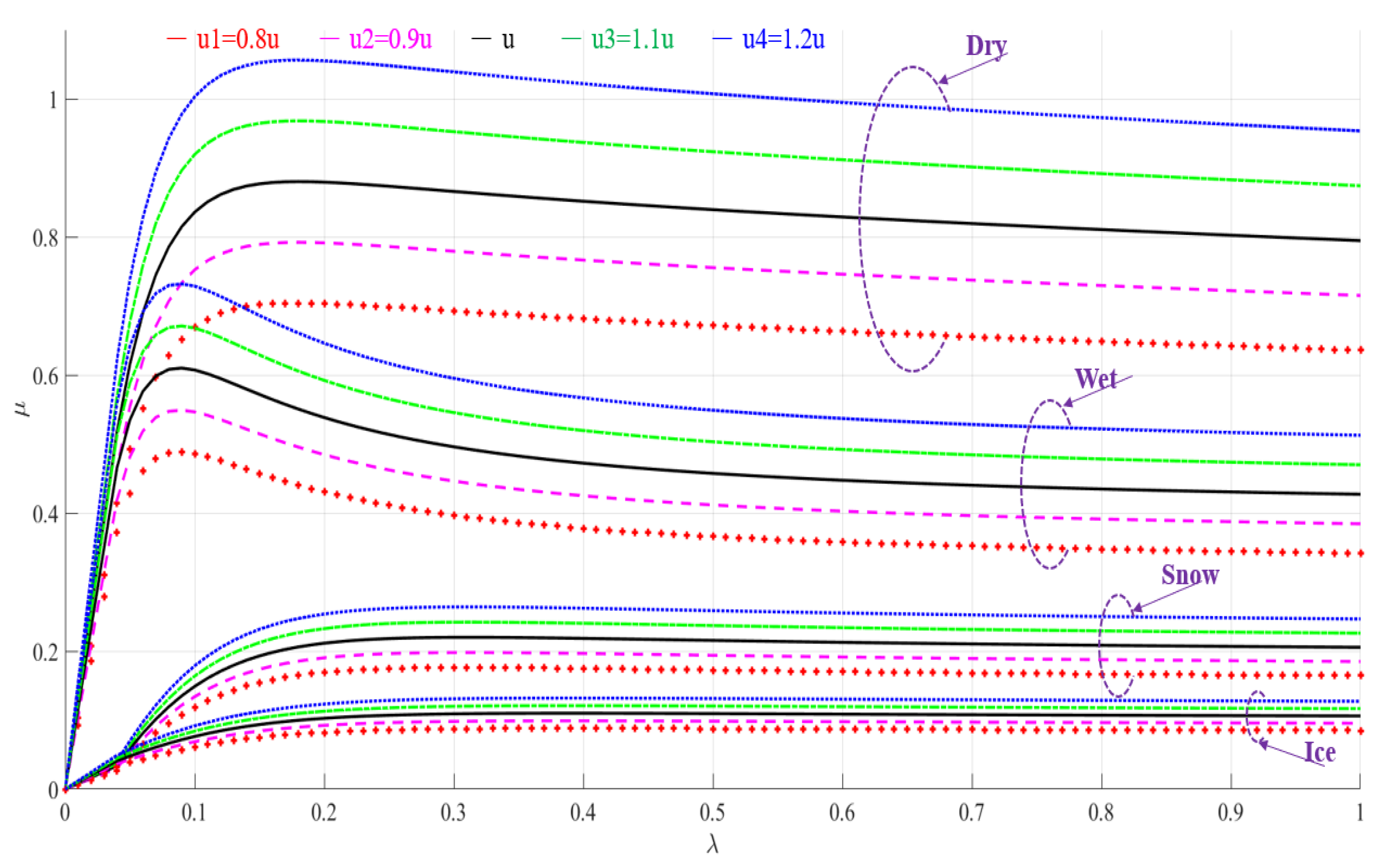
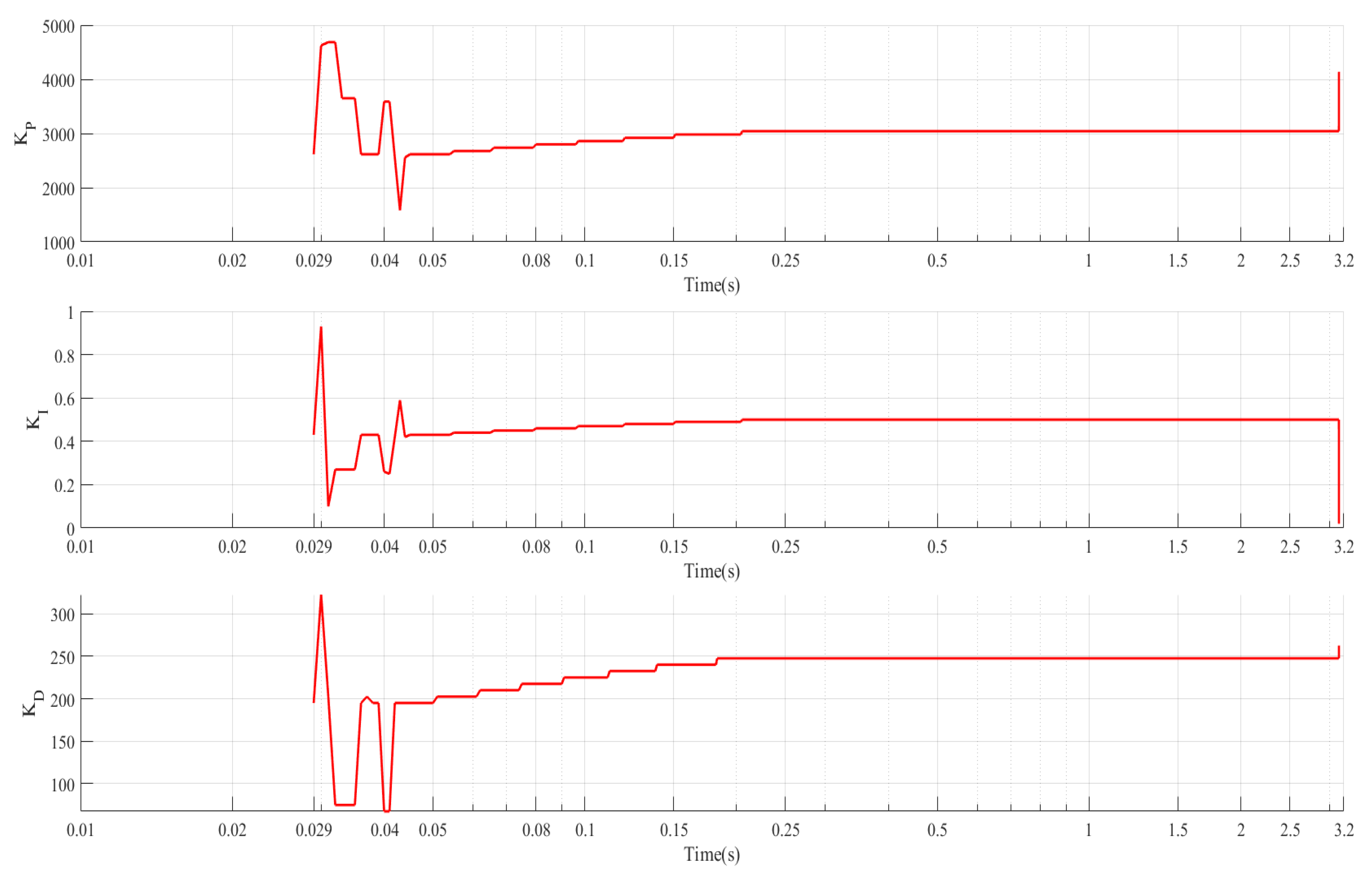
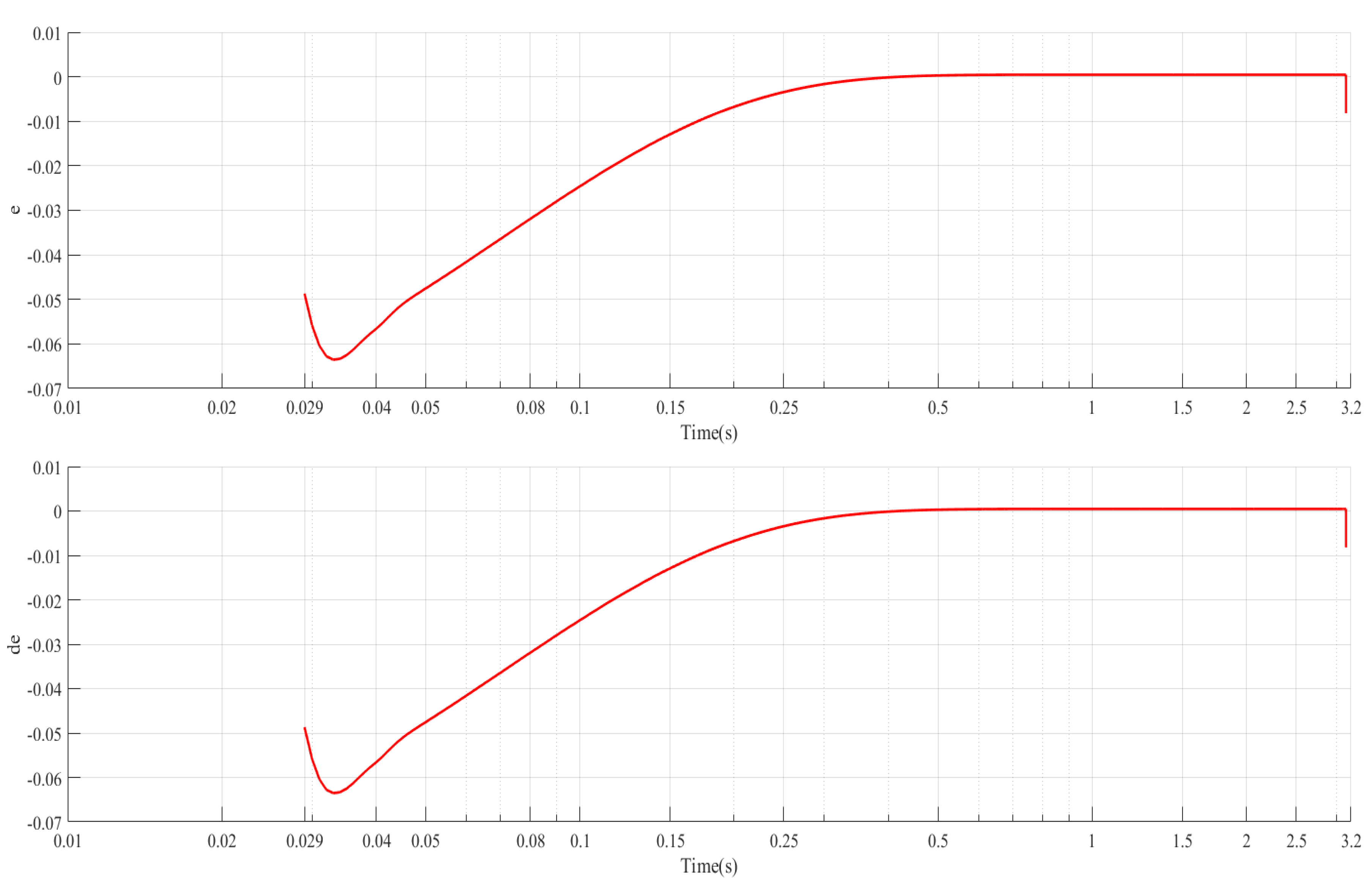
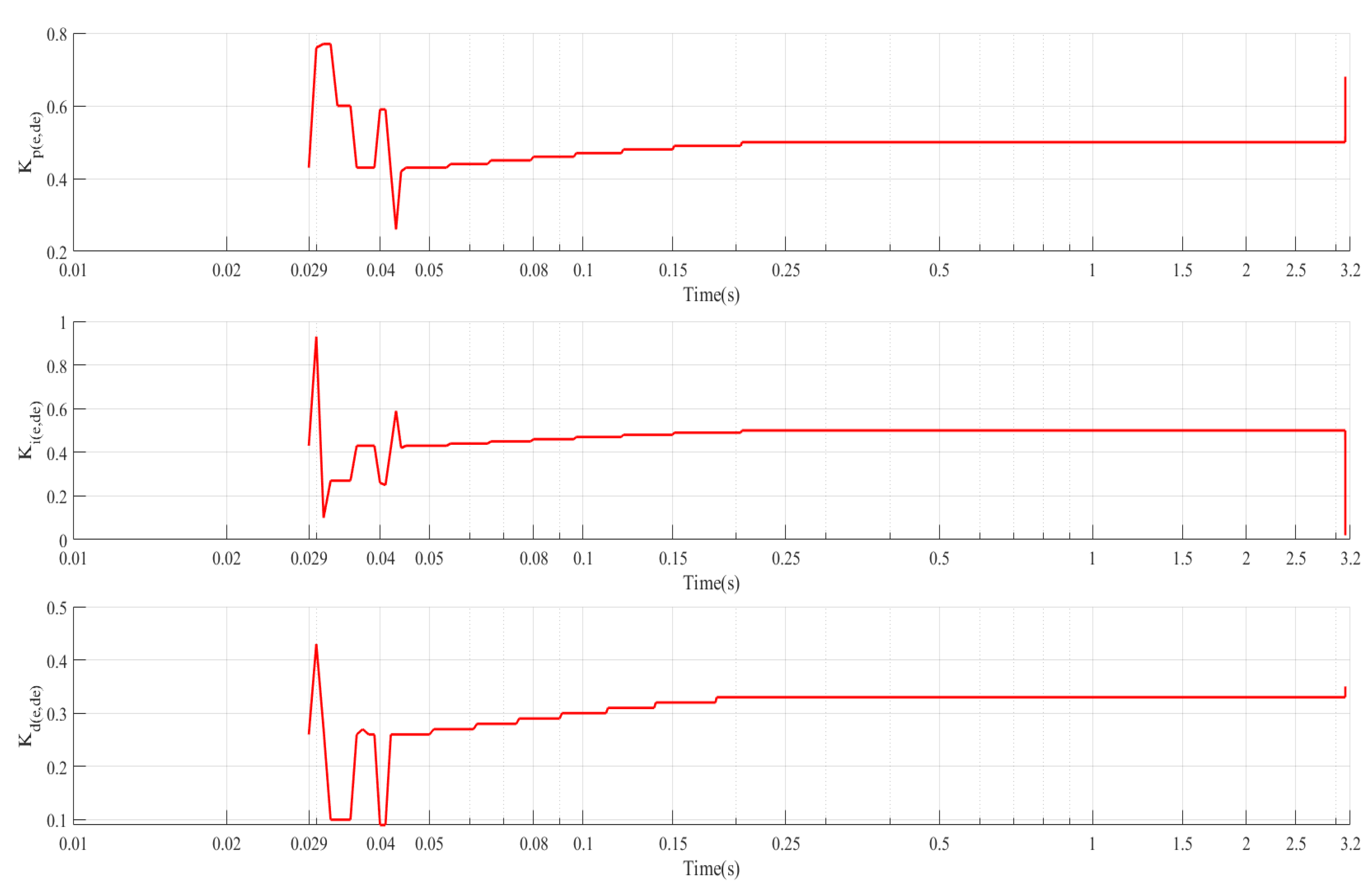
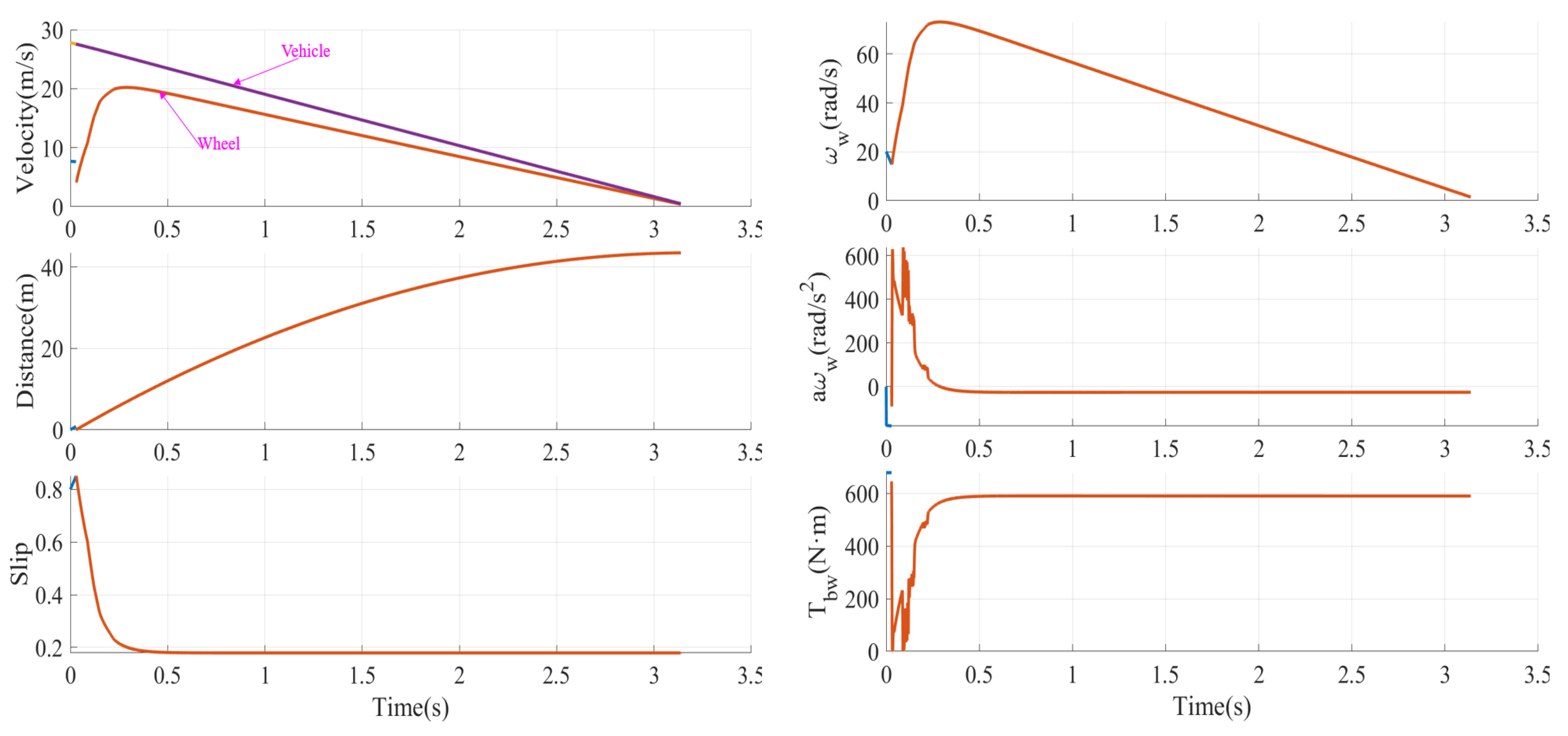
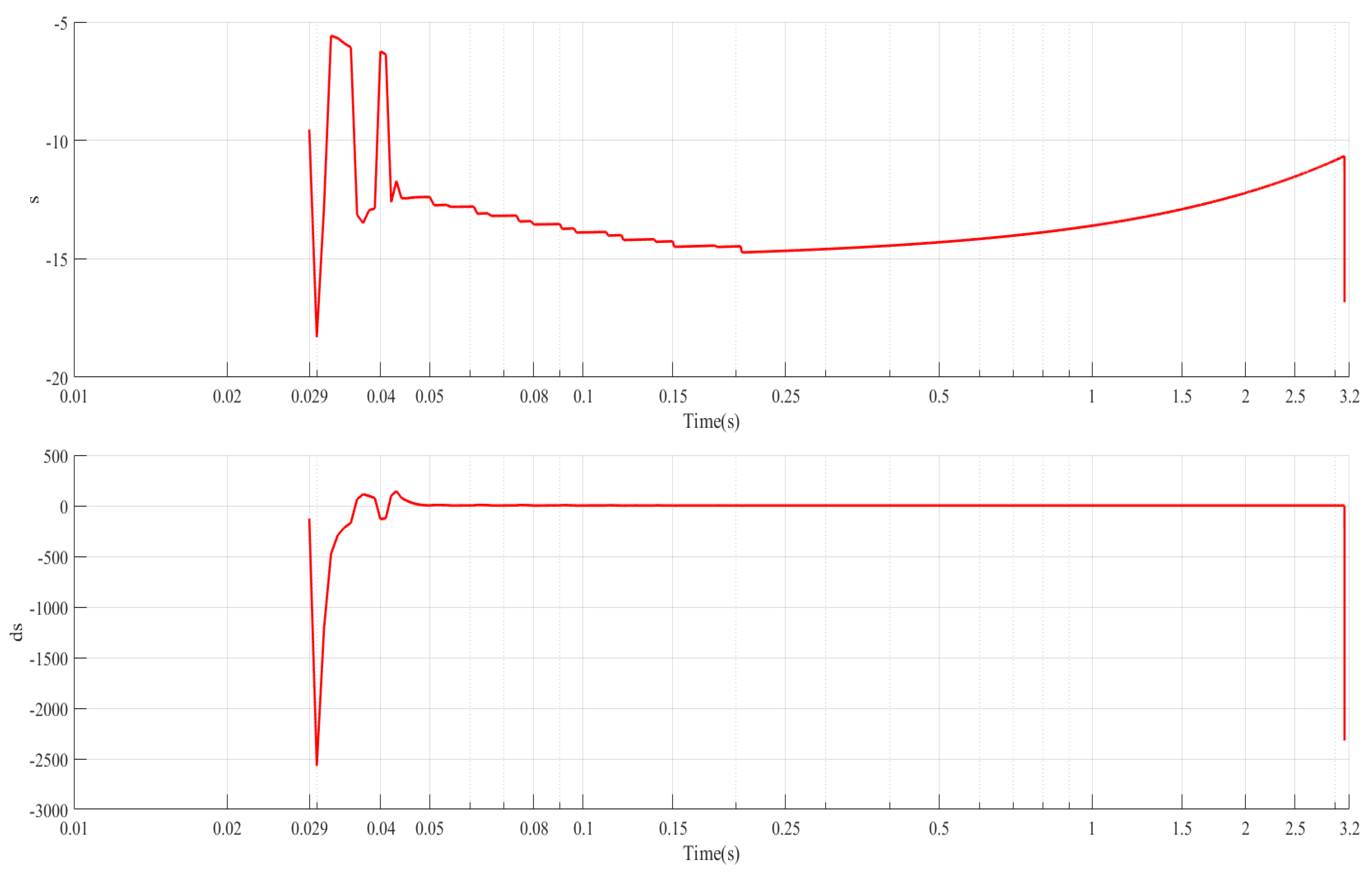
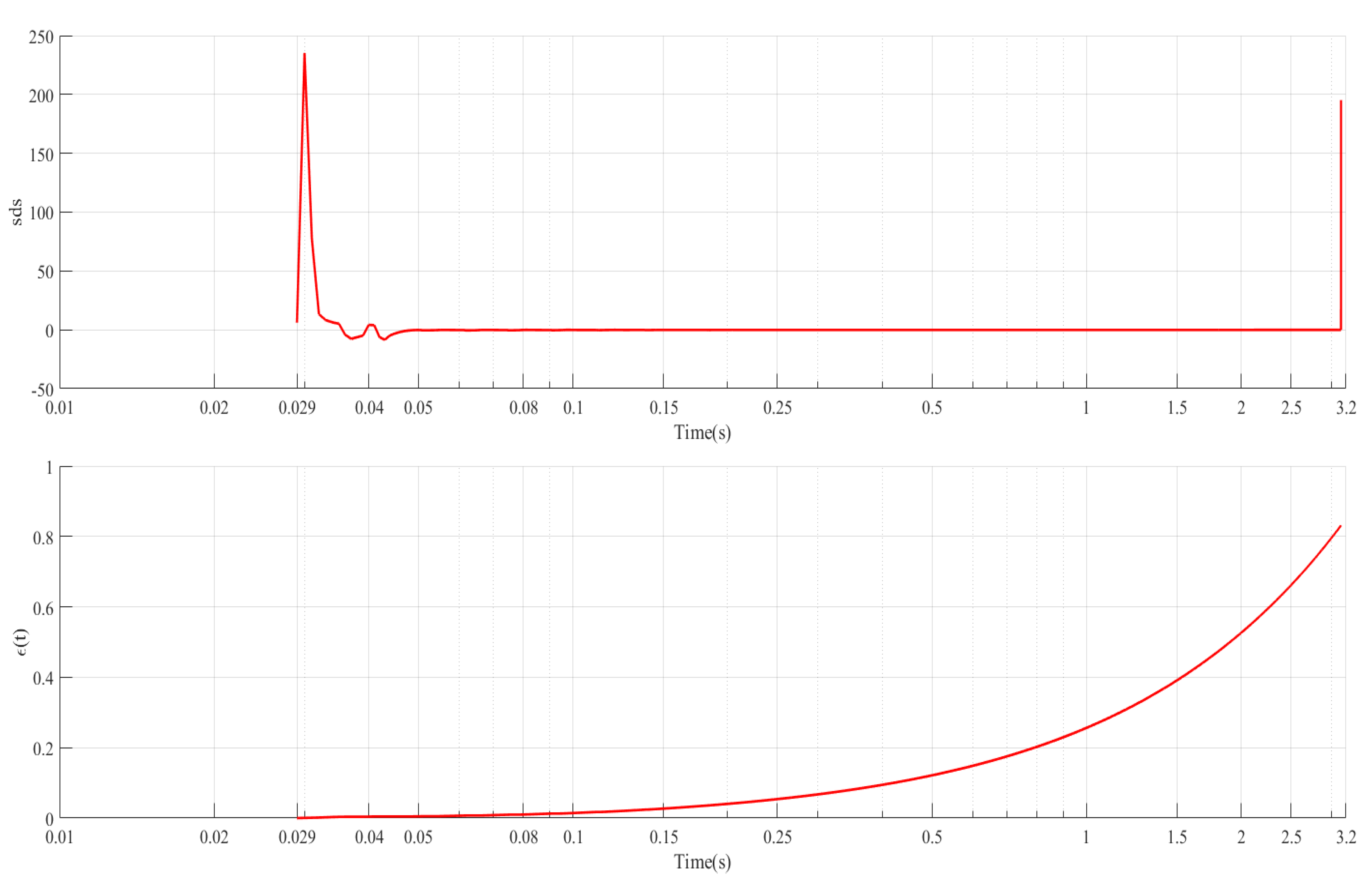
| Road Condition | Slip Ratio (Optimal) | Coefficient (Maxmium) | Coefficient (Slip Ratio = 1) |
|---|---|---|---|
| Dry | 0.18 | 0.8800 | 0.7945 |
| Wet | 0.09 | 0.6099 | 0.4272 |
| Snow | 0.3 | 0.2200 | 0.2055 |
| Ice | 0.37 | 0.1100 | 0.1062 |
| CAB Type | Kp | Ki | Kd | |||
|---|---|---|---|---|---|---|
| Normal PID | 544 | 1 | 750 | |||
| Improved PID | 544 | 1 | 750 | |||
| Kp0 | Kp1 | Ki0 | Ki1 | Kd0 | Kd1 | |
| Fuzzy PID | 68 | 8 | 10 | 0.1 | 25 | 30 |
| Fuzzy sliding Mode | 68 | 8 | 10 | 0.1 | 25 | 30 |
| Road | Velocity (km/h) | s1 | s2 | s3 | s4 | s1 | s2 | s3 | s4 |
|---|---|---|---|---|---|---|---|---|---|
| Dry | 30 | 0.051 | 0.026 | 0.019 | 0.036 | 4.148 | 2.008 | 1.311 | 2.164 |
| 60 | 0.232 | 0.101 | 0.064 | 0.111 | 4.968 | 2.092 | 1.017 | 1.520 | |
| 80 | 0.352 | 0.137 | 0.094 | 0.067 | 4.554 | 1.724 | 0.847 | 0.278 | |
| 100 | 0.375 | 0.157 | 0.126 | 0.189 | 3.524 | 1.371 | 0.731 | 0.870 | |
| Wet | 30 | 0.084 | 0.035 | 0.0173 | 0.031 | 7.057 | 3.263 | 0.302 | 0.297 |
| 60 | 0.324 | 0.129 | 0.003 | 0.234 | 8.193 | 3.727 | 2.435 | 17.215 | |
| 80 | 0.525 | 0.191 | 0.084 | 0.700 | 8.332 | 3.612 | 6.568 | 23.827 | |
| 100 | 0.784 | 0.278 | 0.237 | 1.384 | 8.451 | 3.604 | 9.277 | 27.627 | |
| Snow | 30 | 0.211 | 0.126 | 0.074 | 0.126 | 1.440 | 0.745 | 0.377 | 0.560 |
| 60 | 1.096 | 0.520 | 0.157 | 0.202 | 1.830 | 0.778 | 0.173 | 0.052 | |
| 80 | 1.444 | 0.527 | 0.211 | 0.186 | 1.556 | 0.529 | 0.115 | 0.118 | |
| 100 | 1.791 | 0.567 | 0.083 | 0.008 | 1.387 | 0.418 | 0.026 | 0.485 | |
| Ice | 30 | 0.452 | 0.174 | 0.107 | 0.174 | 0.806 | 0.295 | 0.143 | 0.182 |
| 60 | 1.312 | 0.515 | 0.163 | 0.221 | 0.670 | 0.234 | 0.039 | 0.024 | |
| 80 | 1.772 | 0.582 | 0.173 | 0.092 | 0.592 | 0.181 | 0.014 | 0.082 | |
| 100 | 2.035 | 0.572 | 0.007 | 0.374 | 0.514 | 0.136 | 0.034 | 0.189 | |
| Road | Velocity (km/h) | u1 | u2 | u3 | u4 | u1 | u2 | u3 | u4 |
|---|---|---|---|---|---|---|---|---|---|
| Dry | 30 | 0.969 | 0.423 | 0.174 | 241 | 108.17 | 54.94 | 4.93 | 4.523 |
| 60 | 4.276 | 1.885 | 0.801 | 1.151 | 125.64 | 65.566 | 3.246 | 3.584 | |
| 80 | 7.577 | 3.338 | 1.435 | 1.991 | 130.14 | 68.273 | 2.882 | 2.445 | |
| 100 | 11.7115 | 5.203 | 2.263 | 3.288 | 132.868 | 70.107 | 2.764 | 3.346 | |
| Wet | 30 | 2.461 | 1.198 | 0.135 | 0.174 | 134.356 | 87.944 | 0.753 | 0.478 |
| 60 | 10.490 | 5.185 | 0.612 | 0.813 | 145.51 | 97.557 | 0.756 | 0.759 | |
| 80 | 18.441 | 9.164 | 1.096 | 1.469 | 148.07 | 99.965 | 0.780 | 0.916 | |
| 100 | 28.489 | 14.218 | 1.713 | 2.308 | 149.386 | 101.259 | 0.821 | 0.994 | |
| Snow | 30 | 3.925 | 1.741 | 1.021 | 1.601 | 30.378 | 15.534 | 4.828 | 6.457 |
| 60 | 16.261 | 7.293 | 4.088 | 6.404 | 33.750 | 17.582 | 2.932 | 4.086 | |
| 80 | 1.444 | 12.199 | 7.034 | 11.080 | 1.444 | 17.676 | 2.604 | 3.731 | |
| 100 | 1.791 | 18.399 | 10.957 | 17.179 | 1.791 | 17.947 | 2.631 | 3.749 | |
| Ice | 30 | 7.814 | 3.463 | 2.364 | 3.822 | 16.318 | 8.303 | 3.475 | 3.91 |
| 60 | 29.870 | 13.339 | 8.899 | 14.688 | 17.044 | 8.778 | 2.361 | 3.021 | |
| 80 | 49.098 | 21.925 | 14.790 | 24.439 | 17.146 | 8.841 | 2.202 | 2.917 | |
| 100 | 62.336 | 31.022 | 21.643 | 35.926 | 16.312 | 8.749 | 2.175 | 2.999 | |
| Road | Velocity (km/h) | 0.9M | 1.1M | 1.2M | 1.3M | 0.9M | 1.1M | 1.2M | 1.3M |
|---|---|---|---|---|---|---|---|---|---|
| Dry | 30 | 0.0281 | 0.0281 | 0.0558 | 0.0852 | 35.547 | 35.291 | 70.141 | 104.265 |
| 60 | 0.0287 | 0.0321 | 0.0734 | 0.1015 | 38.981 | 38.814 | 77.266 | 115.682 | |
| 80 | 0.0623 | 0.0462 | 0.1845 | 0.2312 | 39.513 | 39.595 | 77.951 | 116.678 | |
| 100 | 0.0828 | 0.071 | 0.1483 | 0.2151 | 40.131 | 40.111 | 78.55 | 118.545 | |
| Wet | 30 | 0.0239 | 0.0235 | 0.0487 | 0.0759 | 26.801 | 26.385 | 52.177 | 77.218 |
| 60 | 0.0336 | 0.037 | 0.0762 | 0.1119 | 28.073 | 27.918 | 55.436 | 82.724 | |
| 80 | 0.0702 | 0.0738 | 0.1637 | 0.2556 | 28.351 | 27.342 | 53.129 | 78.953 | |
| 100 | 0.1148 | 0.185 | 0.397 | 0.5904 | 28.63 | 24.779 | 48.528 | 72.852 | |
| Snow | 30 | 0.0604 | 0.0711 | 0.1235 | 0.2117 | 9.919 | 9.813 | 19.621 | 29.168 |
| 60 | 0.0101 | 0.1437 | 0.2571 | 0.1295 | 10.616 | 10.417 | 20.822 | 31.348 | |
| 80 | 0.3614 | 0.3282 | 0.6731 | 0.9365 | 10.481 | 10.445 | 20.04 | 30.623 | |
| 100 | 0.7817 | 0.3994 | 1.0853 | 1.6434 | 10.539 | 10.57 | 19.545 | 30.375 | |
| Ice | 30 | 0.0453 | 0.0467 | 0.0967 | 0.136 | 5.371 | 5.37 | 10.724 | 16.092 |
| 60 | 0.3358 | 0.388 | 0.6646 | 0.9685 | 5.443 | 5.408 | 10.835 | 16.242 | |
| 80 | 1.2232 | 1.0938 | 2.0462 | 2.9035 | 5.391 | 5.379 | 10.751 | 16.114 | |
| 100 | 2.6274 | 2.3443 | 4.4511 | 8.2676 | 5.394 | 5.343 | 10.665 | 15.989 | |
© 2019 by the authors. Licensee MDPI, Basel, Switzerland. This article is an open access article distributed under the terms and conditions of the Creative Commons Attribution (CC BY) license (http://creativecommons.org/licenses/by/4.0/).
Share and Cite
Sun, J.; Xue, X.; Cheng, K.W.E. Fuzzy Sliding Mode Wheel Slip Ratio Control for Smart Vehicle Anti-Lock Braking System. Energies 2019, 12, 2501. https://doi.org/10.3390/en12132501
Sun J, Xue X, Cheng KWE. Fuzzy Sliding Mode Wheel Slip Ratio Control for Smart Vehicle Anti-Lock Braking System. Energies. 2019; 12(13):2501. https://doi.org/10.3390/en12132501
Chicago/Turabian StyleSun, Jinhong, Xiangdang Xue, and Ka Wai Eric Cheng. 2019. "Fuzzy Sliding Mode Wheel Slip Ratio Control for Smart Vehicle Anti-Lock Braking System" Energies 12, no. 13: 2501. https://doi.org/10.3390/en12132501
APA StyleSun, J., Xue, X., & Cheng, K. W. E. (2019). Fuzzy Sliding Mode Wheel Slip Ratio Control for Smart Vehicle Anti-Lock Braking System. Energies, 12(13), 2501. https://doi.org/10.3390/en12132501






